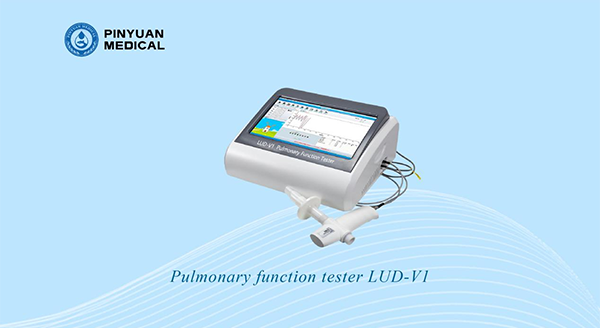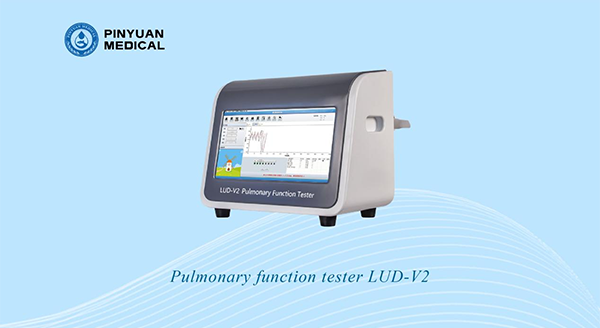In clinical practice, pulmonary function tests are a relatively common method for diagnosing respiratory diseases and are mainly used for the early diagnosis of respiratory diseases. So, what is a pulmonary function test? What is the function of a pulmonary function tester? And what are the precautions when using a pulmonary function tester for pulmonary function tests and how to choose a pulmonary function tester? Today, we will introduce them to you one by one.
What is a pulmonary function test?
On May 20, 2022, The General Office of the State Council issued the “Notice on the 14th Five-Year Plan for National Health”. Incorporate pulmonary function tests into the routine physical examinations of people over 40 years old, promote the measurement of pulmonary function at the first visit for high-risk groups, and enhance the capacity for early screening and intervention of respiratory diseases.
Pulmonary function tests, as an important examination related to respiratory diseases, are a method of testing that detects and analyzes indicators such as gas flow rate, velocity, and volume during human breathing through a pulmonary function tester.
What is a pulmonary function tester?
A pulmonary function tester is a medical device used to detect and evaluate the function of the human respiratory system. It mainly measures parameters such as gas flow, volume, and pressure during the breathing process to reflect the ventilation and gas exchange functions of the lungs and the patency of the airways, providing an objective basis for the diagnosis of respiratory system diseases, condition assessment, and judgment of treatment effects.
How to use a pulmonary function tester correctly?
Basic preparations before use
Before undergoing a pulmonary function test, it is necessary to remain calm, avoid strenuous exercise, smoking and drinking stimulating beverages, and ensure steady breathing. At the same time, it is necessary to understand the testing process and relax so as to better cooperate with the operation.
The correct way to use a mouthpiece
The bite device is a key component for transmitting respiratory airflow in pulmonary function tests, and its usage norms directly affect the accuracy of the tests:
Bite position: Use your upper and lower teeth to gently bite the front end of the mouthpiece, ensuring that the mouthpiece is located on the inner side of your teeth. If the mouthpiece is placed outside the teeth, even if the lips are tightly wrapped to prevent air leakage, the airflow will still be blocked by the teeth when exhaling, resulting in distorted detection data.
Biting force: When biting, the force should be controlled, with the standard of “light biting without loosening”. If you bite with all your teeth, it will cause the bite device to be flattened and deformed, blocking the airflow channel, affecting the normal exhalation of gas and interfering with the test results.
Master the correct exhalation method
The standardization of exhalation movements is the core for obtaining accurate data. The following key points should be noted:
When conducting the test, when the operator issues the blowing command, it is necessary to avoid making vocal exhalation actions such as “whoosh”, “ha”, or “hehe” from the throat (such actions can tense the airway muscles and alter the airflow state). The correct approach is: Imagine there is a lit candle in front of you. Exhale with all your might and at a constant speed, simulating the state of “blowing out the candle without haste”, and ensure that the airflow passes through the mouthpiece continuously and steadily.
Important measures to avoid air leakage
Air leakage will directly lead to lower detection data, and targeted prevention is needed
For the general population: As they are accustomed to breathing through their noses in daily life, during the test, they need to deliberately hold the bite tightly with their mouths, and at the same time, tightly wrap their lips around the edge of the bite to ensure there are no gaps. During exhalation, it is necessary to keep the mouth closed at all times to prevent air from escaping from the corners of the mouth or the nasal cavity.
For special groups: For patients with scleroderma, facial paralysis and other conditions that cause poor lip closure ability, after holding the mouthpiece, gently press the sides of the corners of the mouth with your fingers to assist in closing the mouth, prevent air leakage and ensure the validity of the test data.
By following the above steps, operational errors can be reduced, the accuracy of pulmonary function test results can be guaranteed, and reliable basis can be provided for clinical diagnosis and evaluation.
How to choose a pulmonary function tester?
When choosing a pulmonary function tester, multiple factors such as detection accuracy, comprehensive functionality and clinical applicability need to be comprehensively considered. The pulmonary function test instruments LUD-V1 and LUD-V2 developed and produced by Pinyuan Medical use differential pressure flow sensors to obtain the expiratory flow information of the test subjects. This measurement method can detect multiple indicators, including vital capacity (SVC), forced vital capacity (FVC), minute maximal ventilation (MVV), and dozens of other indicators.
Through these precise indicator detections, scientific and reliable basis can be provided for the early screening and diagnosis of respiratory diseases such as chronic obstructive pulmonary disease (COPD), emphysema, and asthma, helping doctors to make more timely and accurate judgments on the condition and formulate appropriate treatment plans.
Post time: Aug-21-2025


